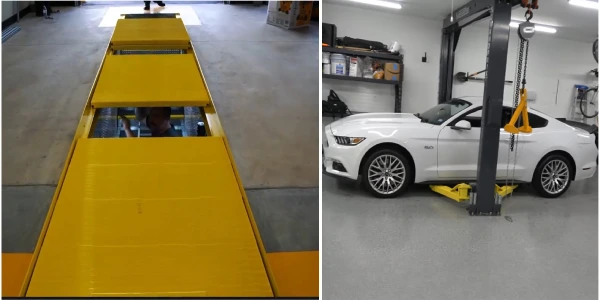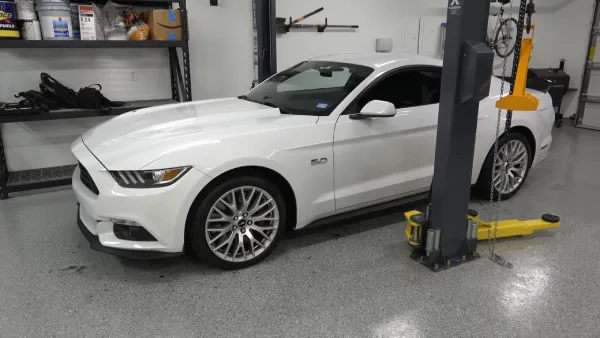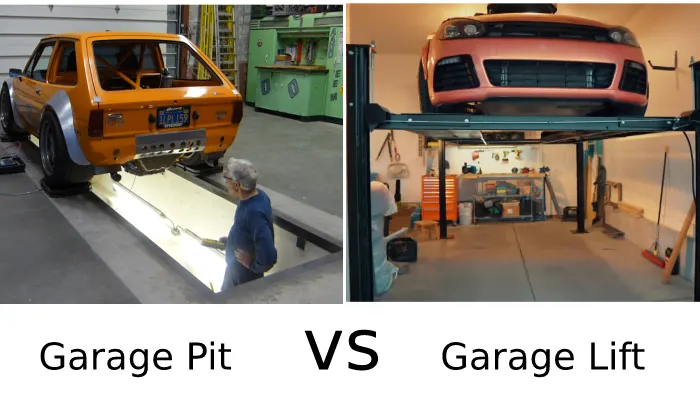Last Updated on April 15, 2023
When it’s time to spruce up your car, you have two paths to choose from, a garage lift or an underground pit. But what makes these options different?
Well, space requirements differ significantly. A garage lift typically requires more space than a pit. On top of that, lifts give you easier access to your vehicle’s underside and offer greater versatility than pits.
Installation-wise, lifts are generally easier and quicker to install than pits, and they can even be portable if you wish. However, lifts may require more maintenance due to their moving parts, which could wear out over time.
Let’s dive deep and see which option is better for keeping your vehicle in pristine condition, the garage pit or a lift. Now let’s explore.
Garage Pit vs Lift: Major Differences

There are a few defining characteristics that separate garage pits from lifts. And knowing these can help you decide which is the best fit for your garage. Below are some of the main differences:
1. Space Requirements
A garage lift and a garage pit may both be used to work on your vehicle, but they have different requirements when it comes to space. Since garage lifts extend upwards, they take up more space than pits.
On the other hand, an inspection pit can be installed in a smaller area because it simply requires digging out an area in the garage floor. You need to consider the size of your garage and how much available space there is before deciding which one is better for you.
2. Accessibility
Regarding accessibility, a garage lift gives you easier access to the underside of your car. This makes it convenient for working underneath as you don’t have to climb over pits.
Since your vehicle is raised up with a lift, this makes various tasks, such as oil changes and repairs, easier compared to using a pit.
Meanwhile, if you choose to use a pit instead of a lift, you will still be able to work underneath your car. But, this will require physical climbing in and out of the pit each time.
There are specific tasks that might not be possible with pits due to their limited range of motion compared to lifts.
3. Convenience
Garage lifts are definitely the more convenient option when it comes to working on your car. All you have to do is push a button to get to the perfect height for working on your car. No physical exertion or getting in and out of a pit is required.
On the other hand, garage pits require you to physically climb into them, which not only takes time but can also be difficult if you’re not as agile or strong.
4. Installation
Installing a garage pit requires quite a bit of effort, as it usually involves excavation and construction work before the actual installation process begins.
It’s not something that most people can do without hiring professional help. Meanwhile, lift installation is generally much easier and quicker, with the less manual effort involved.
5. Cost
Garage pits and garage lifts can both incur high costs depending on the size and type. When it comes to installing a garage pit, excavation and construction are involved, which makes it more expensive than buying and installing a garage lift.
Alternatively, when purchasing a lift, there is the cost of the lift itself as well as installation, which can vary significantly depending on the type and size.
Therefore, when considering cost, it is important to factor in both the purchase and install price before making a final decision.
6. Versatility
Garage lifts offer greater versatility than garage pits because they are designed to work with a variety of vehicles, including cars, trucks, SUVs, etc.
In contrast, garage pits are designed primarily for cars or small vehicles due to their size limitations.
Some lifts can be adjusted to different heights so that they can accommodate larger vehicles, such as vans or pickup trucks, while still providing access to all areas of the vehicle.
7. Portability
Garage lifts are great for those who are looking for a solution that is easy to move around or store when not in use. While garage pits are permanent structures, the portability of a lift offers convenience and flexibility.
A lift can be used in multiple locations within your workspace, or it can be taken with you if you move to a new space. It can also easily be folded up and stored away when not in use.
8. Maintenance
Compared to pits, garage lifts might need more maintenance. Lifts have more moving parts that can wear out over time, which will need to be replaced or repaired for the lift to continue functioning properly.
In opposition to this, pits are static structures and do not have any moving parts that need attention. However, both types of equipment should be regularly inspected for defects and damage to ensure safety when using them.
9. Cleaning
Pits have more surface area than lifts, meaning they take more time and effort to clean, as any filth must be manually removed from the surface area before working on the car.
In comparison, lifts typically require little effort as far as cleaning goes since most of their components are easy to access and clean without getting down into the pit itself.
10. Aesthetics
A lift usually wins out over a pit regarding aesthetics in garages because they come in all kinds of pretty designs.
Some even feature colorful LED lights that can customize the look of your lift while providing increased visibility while working underneath a vehicle at night or in low-light conditions.
Garage pits may not offer this same kind of aesthetic value since they may be hidden beneath flooring material like concrete overlays.
What’s the Safest Option Between the Garage Pit and the Lift?

Regarding safety in the garage, a lift is always the better choice over a pit. Lifts provide more visibility and access to your car from all angles. This means that you can see what you are doing and have greater control of your work.
Lifts are also generally easier to use and offer more stability, making them much safer than pits which can be slippery and dangerous when working.
Additionally, pits pose other safety issues, such as restricted airflow and the potential for hazardous gases to accumulate. Pits are enclosed spaces, which means that any gasoline or gas vapor that has been spilled can settle in the bottom undetected, creating an incredibly hazardous environment.
For all these reasons, lifts are always the better option for garage safety. They provide a secure platform to work on your car while also giving you more visibility and ease of access than pits do.
How Tall Does My Garage Need to Be for a Lift?
If you want to install a car lift in your garage, the minimum ceiling height you need is 12 feet. This will provide enough space for a typical 2-post or 4-post lift and allow for comfortable working underneath it.
You’ll need a high ceiling if you lift larger vehicles, like camper vans. Generally, you should allow for at least 6 feet of clearance from the underside of the lift.
Also, 7 feet of clearance from the vehicle’s wheels, plus 3 extra feet of clearance from any roof timber. So, depending on your height, you’ll probably need a garage ceiling height of 16 feet.
How Deep Should a Garage Pit Be?
A garage pit should be about 10-15 cm deeper than the height of the person using it. This additional depth can provide enough space to work comfortably without having to crouch or bend over too much.
Generally, a garage pit should be at least 24′ long, 6′ deep, and 4′ wide to accommodate most vehicles and activities within it. If you have a larger vehicle or need more room to work around it, you may want to build a larger garage pit.
Your garage pit may need to be deeper if you’re taller than average so you can still work comfortably.
How Thick Does a Concrete Floor Have to Be to Take a Lift?

A concrete floor for a car lift needs to be at least 4 inches thick. This is the minimum thickness recommended for two-post and four-post lifts, though additional thickness may be necessary depending on the size of the lift and the weight capacity.
For a 12,000-pound two-post car lift or higher capacity lift, 6 inches of concrete at 3000 PSI is required. It is best to go as thick as possible when pouring concrete pads for a lift installation, with at least 6 inches of reinforced concrete slab being ideal.
How Much Weight Can a Car Lift Hold?
Depending on the type of vehicle lift you choose, the weight capacity of a car lift can vary a lot. Automotive lifts are available in several weight limit ratings from as low as 7,000 pounds up to 18,000 pounds.
For larger vehicles such as SUVs and pickup trucks, two-post lifts range in capacities from 6,000 to 30,000 lbs. It is important to note that this does not necessarily mean the full weight of the vehicle is always distributed evenly across all four arms of a two-post lift.
To safely lift a 9,000 lb vehicle, the operator must position the vehicle so that each arm carries 2,250 lbs.
Weigh Your Options: Comparing Garage Pits vs. Lifts
In conclusion, when considering whether a garage pit or a lift is right for you and your car project, it’s important to consider all the different factors. Your choice will depend largely on what kind of space you have available in your garage and how much effort you will put into its installation.
Garage lifts offer great accessibility and convenience when compared to pits but may require more maintenance over time.
On the other hand, pits generally require less maintenance but may take longer to install depending on the project’s complexity. Ultimately though, it’ll come down to personal preference, so make sure you weigh all the options before making your final decision.
